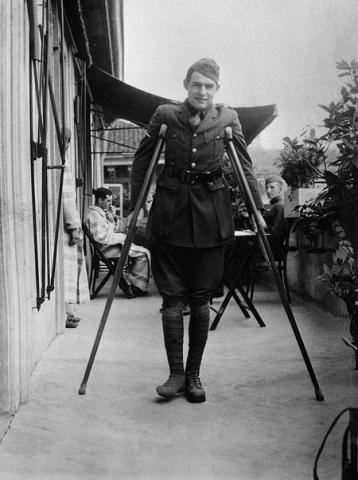
Ernest Hemingway, Milan, 1918. Ernest Hemingway Photograph Collection. John F. Kennedy Presidential Library and Museum.
Ernest Hemingway’s interview for The Paris Review, first published in Issue 18 (1958), is arguably one of the most famous in the journal’s history. And, within that interview, occurs one of the most well-known—if not notorious—discussions of rewriting. George Plimpton asked Hemingway: “How much rewriting do you do?” Hemingway responded: “It depends. I wrote the ending to Farewell to Arms, the last page of it, thirty-nine times before I was satisfied.”
Plimpton’s follow-up question, attempting to dig a little deeper into the mysteries of Hemingway’s creative process, elicited a response that shows the Nobel prize-winning author at his most laconic. The answer is part evasion, part put down, and I have never been able to read it without feeling that Hemingway was having some fun at the earnest young interviewer’s expense:
INTERVIEWER
Was there some technical problem there? What was it that had stumped you?
HEMINGWAY
Getting the words right.
In in his introduction to this interview Plimpton described Hemingway’s tone as “waspish,” in large part because of the novelist’s “strong feeling that writing is a private, lonely occupation with no need for witnesses until the final work is done.”
Plimpton’s preparatory notes and questions for his Hemingway interview, as well as the revised typescript, is part of The Paris Review archive at the Morgan. Looking through the files a few days ago I was struck by the single page that records this entire exchange. It is well-known that The Paris Review interviews are collaborative in nature, the result of “a combination of face-to-face encounters and later revision” (as Robert Douglas-Fairhurst noted in his review of the first volume of The Paris Review Interviews.) What this typescript page reveals is that Plimpton revised his lead-up question, as well as Hemingway’s initial answer. The original typescript version (shown above) reads:
Q: Do you do much re-writing?
A: Sometimes. I re-wrote the ending to Farewell to Arms, that last page, thirty-nine times before I got it right.
It’s immediately obvious how Plimpton’s revisions improved their conversation after the fact: the first question is less open ended, it takes rewriting as a given; Hemingway’s vague “sometimes” becomes conditional, and is slightly more nuanced. But the most important revision is the deletion of “got it right” to “was satisfied.” Without this, the pungency of Hemingway’s answer to the follow-up question (“Getting the words right”) would read as mere repetition of his preceding statement. And, without these revisions, this portion of the interview would have been less notable, Hemingway’s repetition of “right” a further sign of irritability and avoidance. This we owe to Plimpton, who knew that the interviewer’s task is to shine a light on his subject, to be simultaneously present and absent. His revisions show how relatively minor changes can enhance the impact and resonance of an answer. It’s a perfect example of the interview as contrived double act.
We are unable to include an image of the typescript page described above due to copyright restrictions. But if you are interested in exploring the many other ways Plimpton and Hemingway developed this interview you can make an appointment with the Sherman Fairchild Reading Room. The Paris Review interview files are quite a revelation. And, if you missed our exhibition Ernest Hemingway: Between Two Wars, you can still see it for a little longer at Boston’s John F. Kennedy Library and Museum (the exhibition closes on December 31), or watch an overview of the Morgan’s exhibition on NYC-Arts.
